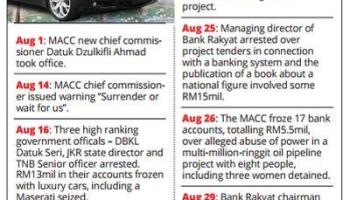Logo Jabatan Air Negeri Sabah - http://malaysianlogo.blogspot.my/2014/06/jabatan-air-negeri-sabah-sabah.html
KOTA KINABALU: Everywhere in Sabah, there was only one topic – the huge stash of cash found in the homes of Sabah Water Department director Ag Tahir Ag Talip and his deputy Teoh Chee Kong.
Sitting in the lap of luxury: There’s more to Ag Tahir (left) and Teoh than meets the eye.
And what made Sabahans even more upset was the fact that there are many areas in Sabah still without proper piped water and disruptions are common. The usual excuse is: there are insufficient funds to carry out projects.
One resident from Sabah’s northern Kota Marudu said many villagers have been asking the state Water Department to get piped water and meters for their houses.
But the officials often said there were no funds although the main water pipe ran past their village.
“We suffer without water especially during the dry season. They have never entertained us because we can’t pay for the deposit,” said a Kota Marudu resident.
“It is not a question of envy. It is theft of public funds to me,” said restaurant owner Cheah Kok Lo.
A Beaufort resident, Rosita Ismail, 35, said: “I hope their arrest will serve as a lesson to future leaders.
“Don’t keep telling us the government has no money and to be patient,” she added.
Giant treasure trove - 38 companies got million-ringgit deals while public left without water
They lived like ordinary people, with only the luxury cars giving a hint of the wealth they have amassed. But even MACC investigators are shocked at the amount of money two top officers of the Sabah Water Department skimmed from projects in a state where many areas do not have piped water. The treasure just got bigger, too – another RM870,000 in cash and more jewellery have been recovered and the total could hit RM300mil.
Proof is in the mansion: Teoh’s house in Luyang near Kota Kinabalu.
KOTA KINABALU: Thirty-eight companies owned by family members and proxies of Sabah Water Department director Ag Tahir Ag Talib and his deputy Teoh Chee Keong were given water contracts worth millions for RM3.3bil worth of federal projects since 2010.
Malaysian Anti-Corruption Commission (MACC) sources said that 17 of the companies were held by siblings and family members of Ag Tahir and another 21 companies were owned by Teoh’s relatives.
The sources said the 54-year-old director and his 52-year-old deputy will be made to declare all their assets under Section 36 of the Malaysian Anti-Corruption Act 2009 as the MACC wants comprehensive details of their wealth.
“We want to know what they own in a comprehensive way,” MACC deputy chief commissioner Datuk Azam Baki said yesterday.
He said they needed the two to give full details of their property and wealth. The sources said 40 witnesses have been identified, mainly Water Department officials and contractors.
Asked about talk that a few witnesses had left the country, Azam said all witnesses wanted by MACC were in Sabah.
He said they were gathering more documents and information in their investigations into the case, which involves abuse of power, nepotism, cronyism, bribery and money laundering.
Azam said they would be using Asean’s Mutual Legal Assistance Agreement (MLA) to get cooperation from a neighbouring country to get back money stashed in a bank account linked to the duo.
He said a special MACC team of investigators involving 70 personnel has been working on the case since last year.
Another RM870,000 and gems recovered as safes are opened
KOTA KINABALU: Graft investigators are still amazed at why two top officials of the Sabah Water Department kept a whopping RM53.7mil cash with them as the wealth continued to pour out of bank safe deposit boxes.
An additional RM870,000 in cash and a large amount of jewellery were recovered yesterday after Malaysian Anti-Corruption Commission (MACC) investigators opened the last of the boxes.
The MACC is expected to call jewellers to assist in estimating the value of the jewellery recovered.
The investigators, who have been questioning the director Ag Tahir Ag Talip and his deputy Teoh Chee Kong for the past 72 hours, have yet to get answers on the source of cash found in both their houses and offices.
“We don’t know yet. We are recording their statements but we still have not established how and why they had such a large of amount of money,” an MACC investigator said on condition of anonymity.
Sources said the designer watches seized have also yet to be valued.
The 127 property and land titles found at the deputy director’s house might easily be worth over RM60mil in conservative estimates, the sources said.
“At the end of the investigations, we might be looking at between RM200mil and RM300mil in total,” the source added.
The two are under investigations for alleged abuse of power, kickbacks and money laundering in connection with RM3.3bil worth of contracts for federal-funded projects given out by the Water Department in Sabah since 2010.
By Muguntan Vanar and Stephanie Lee The Star/ANN
Modest cover for a pile of treasure
KOTA KINABALU: On the outside, they were well-paid civil servants who were living modest lives and not known to flash their wealth.
But behind closed doors, they were sitting on a mind-boggling amount of cash, jewellery, watches and cars.
Sitting in the lap of luxury: There’s more to Ag Tahir (left) and Teoh than meets the eye.
Sabah Water Department director Ag Tahir Ag Talip and his deputy Teoh Chee Kong were quite well-known in their neighbourhoods but no one had the faintest idea of the pile of treasure they were sitting on.
The 54-year-old Ag Tahir did have a penchant for luxury cars.
“He keeps to himself and he does not socialise much although he is well known,’’ said a person who knows him.
He said he had seen the director use most of the luxury cars which were seized by the MACC on Wednesday.
“I’ve seen him in the Range Rover. I believe all the cars in the media pictures are his. I’ve seen him driving those vehicles,” he said.
However, it is not known if the vehicles were registered under under Ag Tahir’s name.
It is learned the cars were seized from the house of one of his family members.
The nine luxury vehicles seized included a Range Rover V8 (worth RM1.1mil), Mercedes Benz C300 (RM308,000), Audi A1 (RM180,000) and Lexus ES (RM260,000).
Others familiar with Ag Tahir said he is from Sabah’s south-western Bongowan in Papar district. He was not known to be a show-off although he did take overseas holidays. He is a father of three – two daughters and one son – with the older daughter married with her own family.
The 52-year-old Teoh, from whose house and office graft investigators seized some RM7.5mil cash and 127 land titles and grants, was described as a very low-profile officer who moved around in an old Toyota Vios.
He lives in a bungalow in Luyang here, was from Sabah’s south-western Beaufort district. However, he had made many trips to Australia and might have been planning to migrate.
An engineer by training, he was from a well-to-do Sabah family involved in construction, development and hotel businesses. Friends and associates describe him as a very helpful person who never flashed his wealth.
“He does not even wear a watch,’’ a friend said.
Teoh had been in the post for about four years and was also in charge of the department’s west coast water operations.
Both have been remanded for a week since Wednesday.
MACC officers have also arrested a contractor with the title of Datuk and his company accountant.
More arrests are expected as they also try to trace money banked into a neighbouring country.
Jewellery seized from Sabah Water Dept duo valued at over RM3mil
Some of the watches, rings and necklace seized from the homes of the civil servants in Kota Kinabalu.
KOTA KINABALU: Jewelleries that were seized from the two senior officers of the Sabah Water Department following corruption investigations have been valued at more than RM3.6mil.
It is learnt that the valuables seized from department director Awang Tahir Awang Talip (pic) weighed some 14.5kgs, with a bank valuing them at about RM2.74mil.
The ones recovered from the deputy director, Teoh Chee Kong, have been valued at around RM900,000.
Sources said the valuation process of the jewelleries, including watches, gold rings, bracelets and necklaces, was carried out from 10.30am to about 12.15pm on Friday.
Tahir and Teoh have been remanded following their arrest on Tuesday by Malaysian Anti-Corruption Commission officers who discovered over RM114mil, including RM53mil cash, and valuables in their homes and offices.
 PWD director claims trial to two charges
PWD director claims trial to two charges
KUALA LUMPUR: Malacca’s Public Works Department director Datuk Khalid Omar was charged in a Sessions Court here with two counts of money laundering involving more than RM4mil.
Khalid, 56, was accused of money laundering activities totalling RM2,135,634.13 in his Amanah Saham Didik account on July 1, last year. He also faced a second charge of having RM1,984,797.08 in his Amanah Saham Wawasan 2020 account which was the proceeds from illegal activities, on Sept 1, the same year.
The offences were alleged to have been committed at Amanah Saham Nasional Berhad, Menara PNB, Jalan Tun Razak here.
He was charged under Section 4(1)(b) of the Anti-Money Laundering, Anti-Terrorism Financing and Proceeds of Unlawful Activities Act 2001 (Act 613).
Khalid claimed trial before Judge Azura Alwi yesterday.
Judge Azura then granted deputy public prosecutor Ahmad Akram Gharib’s request to transfer the case to the Sessions Court in Malacca.
On Sept 29, Khalid claimed trial in a Sessions Court in Malacca to 16 counts of corruption and money laundering, involving more than RM1.28mil.
He pleaded not guilty to all charges – 13 for corruption and three for money laundering. Judge Meor Sulaiman had set bail at RM100,000 for the corruption charges and RM150,000 for the money laundering charges with one surety. Khalid posted the bail.
The court set Nov 4 for mention.
TI Malaysia: Set cap on civil servants’ tenure
KUALA LUMPUR: Transparency International Malaysia is calling for a maximum tenure of three years for senior civil servants, following the biggest ever seizure by the Malaysian Anti-Corruption Agency (MACC) in Sabah.
Its president Datuk Akhbar Satar said putting a cap on the tenure could prevent the officials from getting too close to their clients and being influenced by those with money.
However, those with corrupt intent would surely find a way to cheat, he added.
“Therefore, the most important thing is, the handlers must have integrity,” he said, adding that a crisis of integrity is looming in the country.
On Wednesday, the MACC seized RM114mil worth of cash from the homes and offices of the Sabah Water Department’s director and his deputy, besides also recovering luxury vehicles, watches, jewellery and handbags.
Akhbar said he was surprised the officers could, and dared to, amass the amount of cash and luxury products.
“It’s a red flag if the officers are living beyond their means,” he said.
Citing statistics from the Association of Certified Fraud Examiners, Akhbar said 5% of a company’s revenue is lost to fraud each year.
He said the prevention unit of the MACC and the Malaysian Institute of Integrity should be roped in to train staff members.
“Don’t just train them on how to improve productivity or get promoted. Make them sit for anti-fraud courses from time to time, too.”
For checks and balances, Akhbar suggested that huge projects by government departments must be approved by an oversight committee, a common practice in Britain and many European countries.
Centre to Combat Corruption and Cronyism (C4) founder Cynthia Gabriel said besides limiting the tenure of top government officers, declaration of assets once every few years should also be made compulsory.
She added that annual reports of government departments must be published for the public to keep track of their activities, expenditure and projects.
By Tho Xin Yi The Star/ANN
Related posts:

Sep 21, 2016
... PBA in a fix over Penang water cut;
billion litres water waste via leaky pipes.
Water letdown: Residents waiting for their pails to be filled by a ...

































